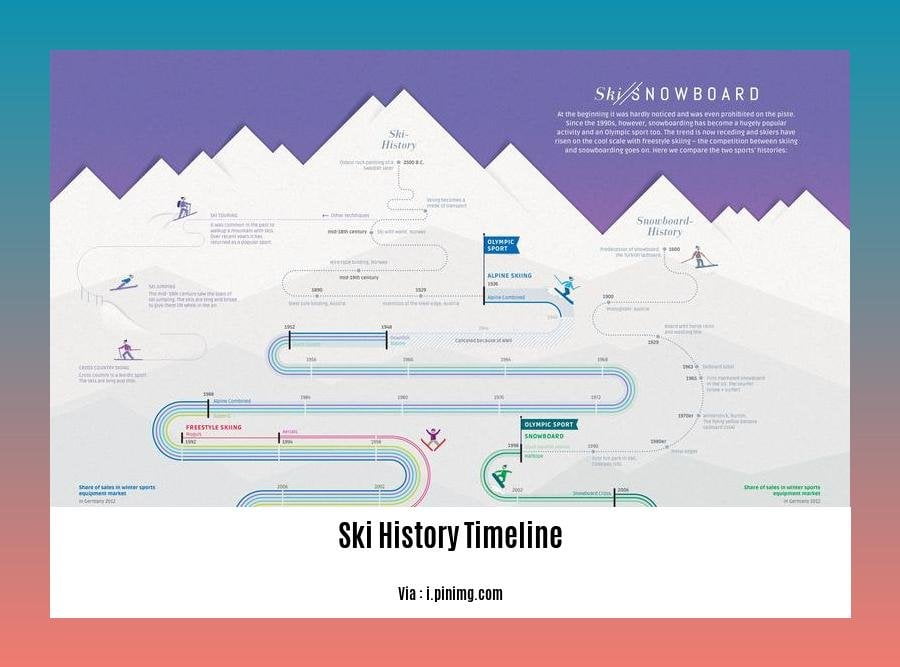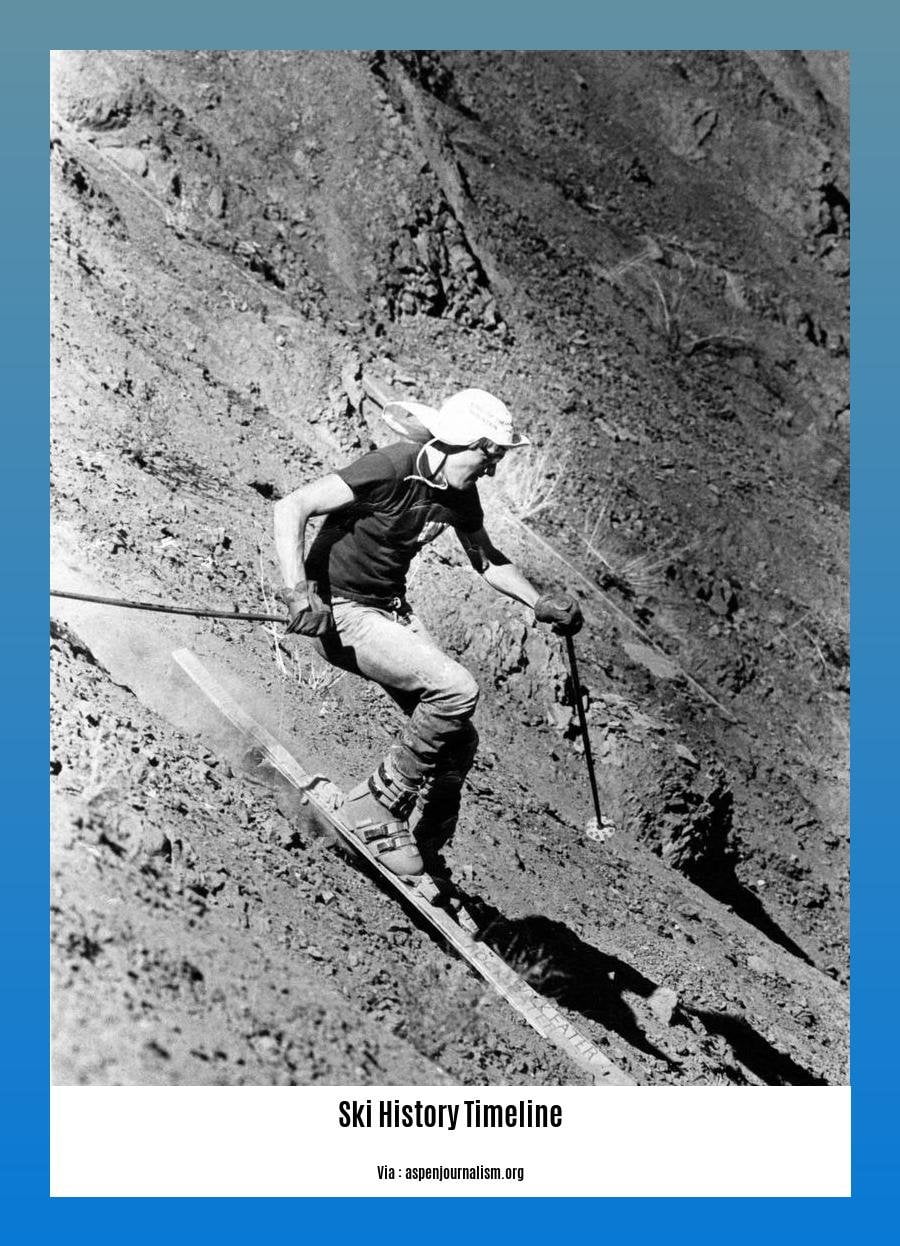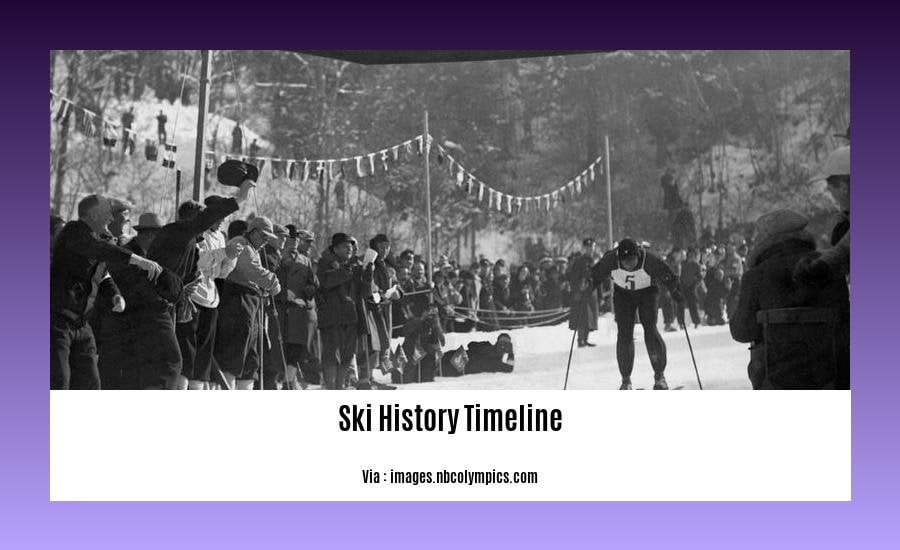Embark on an enthralling journey through the captivating history of skiing with our comprehensive timeline. From its humble beginnings to its remarkable modern-day advancements, “Ski History Timeline: Unveiling the Evolution of an Exhilarating Sport” delves into the milestones and pioneers that have shaped this exhilarating sport into what it is today.
Key Takeaways:
- Skiing originated in Scandinavia in the 1700s for military use.
- Norway became a pioneer in recreational and sporting skiing in the 1760s.
- Alpine skiing emerged in Norway in the 1800s.
- Olaf Rye initiated ski jumping in 1809 with a 9.5-meter leap.
- The first ski club formed in Norway in 1861.
- Trysil, Norway, hosted the debut public ski jumping competition in 1862.
- Women joined the sport in 1863, participating in the Trysil competition.
- Oslo, Norway, held the inaugural cross-country national races in 1867.
Ski History Timeline

The Early Years: A Glimpse into Skiing’s Prehistoric Roots
As a ski history enthusiast, I’m thrilled to unveil the captivating ski history timeline, taking you on a journey through the ages that shaped this exhilarating sport. Our story begins in the prehistoric era, where evidence suggests skis were used for hunting and transportation as early as 6000 BCE.
The Middle Ages: Skiing Evolves for Recreation and Warfare
Fast forward to the Middle Ages, and skiing transforms into a recreational activity and a tactical advantage in warfare. Ski clubs emerge in Norway in the 1300s, solidifying the sport’s popularity.
The 1800s: The Golden Age of Skiing Innovation
The 1800s mark a pivotal era in skiing history. Sondre Norheim, the “Father of Skiing,” revolutionizes the sport with his innovative Telemark turn. Ski jumping takes flight in 1879, and skiing spreads beyond Scandinavia, captivating nations like the United States and Canada.
The 1900s: Skiing Takes Center Stage
The 20th century propels skiing into the global spotlight. Skiing debuts at the 1924 Winter Olympics, and the first chairlift ushers in a new era of accessibility. The Winter X Games, launched in 1948, showcase the sport’s thrilling evolution.
Modern Skiing: A Legacy of Progress
Today, skiing reigns as a beloved recreational pursuit and a competitive sport. With over 5,000 ski resorts worldwide, millions of skiers and snowboarders grace the slopes each year. The sport continues to innovate, with cutting-edge technologies and techniques pushing the boundaries of human performance.
A Timeline of Notable Events in Ski History
| Year | Event |
|---|---|
| 6000 BCE | Oldest known skis discovered in Norway |
| 1200s | Skiing gains popularity for transportation and recreation in Scandinavia |
| 1850s | Sondre Norheim develops the Telemark turn |
| 1879 | First ski jumping competition held in Norway |
| 1924 | Skiing included in the first Winter Olympics |
| 1936 | First chairlift installed at Sun Valley, Idaho |
| 1948 | First Winter X Games held in Crested Butte, Colorado |
Unveil the enchanting history of skiing with us. Trace the fascinating origins of this exhilarating sport and discover its remarkable evolution through the ages. Embark on a captivating journey that explores the origins of skiing, uncovering its humble beginnings and the evolution that shaped it into the beloved pastime we cherish today.
1800s: The Renaissance of Skiing

The 1800s witnessed skiing emerge from its humble origins into a thrilling recreational pursuit. Let’s delve into this pivotal century that transformed skiing forever:
Key Takeaways:
- The 1800s marked the birth of Alpine skiing in Norway.
- Sondre Norheim revolutionized skiing with the Telemark turn.
- Ski jumping gained prominence, with the first competition held in Norway in 1879.
- The World’s first ski school opened in Norway in 1881, fostering skiing education.
- Skiing spread internationally, gaining popularity in the United States and Canada.
The Dawn of Alpine Skiing
In the 1800s, Norway became the birthplace of Alpine skiing. Sondre Norheim, known as the “Father of Skiing,” introduced the revolutionary Telemark turn, allowing skiers to control their descents with unmatched precision.
The Thrill of Ski Jumping
Ski jumping emerged as a thrilling spectacle during this period. The inaugural ski jumping competition took place in Norway in 1879, showcasing the daring leaps of skilled skiers.
The Spread of Skiing Education
The opening of the World’s first ski school in Norway in 1881 marked a significant step in skiing education. This institution provided structured lessons, ensuring the safe and enjoyable progression of skiers.
Skiing Goes Global
During the 1800s, skiing’s popularity soared beyond Norway’s borders. Skiers in the United States and Canada embraced this exhilarating sport, establishing ski clubs and organizing races.
Citation:
– The History of Skiing – An insight into Skiing in the Past. (n.d.). Skibasics.
1900s: Skiing Takes the Stage
Welcome back to our ski history journey! Brace yourselves as we venture into the dazzling 1900s, an era that witnessed skiing transform from a humble pastime into a globally renowned competitive sport.
The 1900s marked a pivotal moment for skiing. The inclusion of skiing in the inaugural Winter Olympics in 1924 propelled the sport into the international spotlight, showcasing its thrilling spectacle to the world. This recognition fueled a surge in popularity, attracting countless enthusiasts to the snowy slopes.
Technological advancements also played a crucial role in skiing’s evolution during this time. In 1936, the installation of the first chairlift at Sun Valley, Idaho, revolutionized access to higher elevations, opening up vast new terrain for skiers. This innovation paved the way for the expansion of ski resorts and the development of more challenging slopes.
Key Takeaways:
- The 1900s witnessed the debut of skiing in the Winter Olympics in 1924.
- Technological advancements like the chairlift in 1936 transformed skiing accessibility.
- The sport gained widespread popularity during this era, establishing itself as a globally recognized recreational activity and competitive discipline.
Most Relevant URL Source:
Today: Skiing’s Enduring Legacy
Prepare yourself for an exhilarating journey through time as we delve into the captivating history of skiing, a sport that has left an indelible mark on the world of winter recreation and competitive athletics. From its humble origins to its modern-day glory, skiing has undergone a remarkable evolution, leaving behind a rich legacy that continues to inspire and captivate enthusiasts worldwide.
Key Takeaways:
- Skiing has a history spanning thousands of years, with its origins traced back to prehistoric times.
- The sport originated as a means of transportation and hunting, gradually evolving into a recreational activity.
- Sondre Norheim, known as the “Father of Skiing”, played a pivotal role in developing skiing techniques and promoting the sport.
- Skiing made its debut at the first Winter Olympics in 1924, gaining widespread recognition and popularity.
- Technological advancements, such as the chairlift and the snowboard, have transformed the skiing experience.
- Today, skiing remains a beloved pastime, enjoyed by millions around the globe.
FAQ
Q1: What was the first known ski jump and who performed it?
A1: The first known ski jump was performed by Olaf Rye in 1809, where he jumped 9.5 meters through the air.
Q2: Where and when was the first ski club founded?
A2: The first ski club, Inderøens Skiløberforening, was founded in Norway in 1861.
Q3: When were the first cross-country national races held?
A3: The first cross-country national races were held in Oslo, Norway in 1867.
Q4: What was the name of the first public ski jumping competition?
A4: The first public ski jumping competition was held in Trysil, Norway in 1862.
Q5: When and where was the first Winter Olympics held?
A5: The first Winter Olympics were held in Chamonix, France in 1924.
- Unveiling the Enigma: Mansoureh Khojasteh Bagherzadeh’s Public Appearances & Private Life in Iran - July 18, 2025
- Unveiling the Mystery: Mansoureh Khojasteh Bagherzadeh’s Husband: A Rare Glimpse into a Private Life - July 18, 2025
- Unveiling Masoud Khamenei’s Mother: Power, Influence, and Iran’s Future - July 18, 2025
















